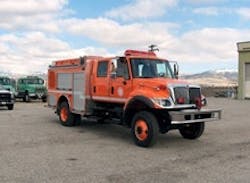Texas Storm Water System Provides Fire Protection
In parched West Texas, establishing and maintaining water sources for fighting range and structure fires can be a challenge.
The distance between ample water sources and fire sites can pose a problem, according to Logan Boswell, Texas AgriLife Extension Service agricultural agent for Jeff Davis and Brewster counties.
Boswell cited the McDonald Observatory, a star-gazing structure 6,500 ft high atop Mount Locke, as a prime example. "Most of their water must be pumped from several miles away and then up the mountain," he said. "For years there has been very little water storage available on top of the mountain for fire fighting, and wildfires are common in the Davis Mountains."
About two years ago, Mike Mecke, a recently retired AgriLife Extension water programs specialist, set out to remedy the situation based on solutions he had seen implemented in Arizona. "There, they were paving areas in the mountains in remote locations to create mini catchments," Mecke said. "The rainfall that hit the paved areas ran into large covered tanks by gravity flow. The stored water was for livestock and desert wildlife. I knew t he same thing would work at McDonald Observatory using their parking lot. The water here, though, would be strictly for fire fighting."
Mecke purchased a large, covered metal tank through Pioneer Tank, an Australian company. Funding came through a project involving McDonald Observatory, part of the University of Texas at Austin, and the Texas Water Resources Institute, part of Texas A&M University. A distributor installed the tank with help from Boswell and McDonald Observatory staff. The tank's water supply will be used to protect buildings, structures, the 100-plus people who live nearby and many visitors.
"Every inch of rain falling on that paved area produces 42,000 gal of runoff," Mecke said. "Any excess is diverted down a dry creek bed." The area's average annual rainfall is 18 in., according to Mecke; the parking lot and tank, then, have the potential to yield 756,000 gal of water a year.
"There's a lot of potential fire protection," Mecke said. "... The new tank, with its connection for a fire fighting pump to load fire trucks quickly, should become a real asset during times of prolonged dry weather. My dream is to see a number of these placed in strategic spots throughout this area."
Source: AgNews


